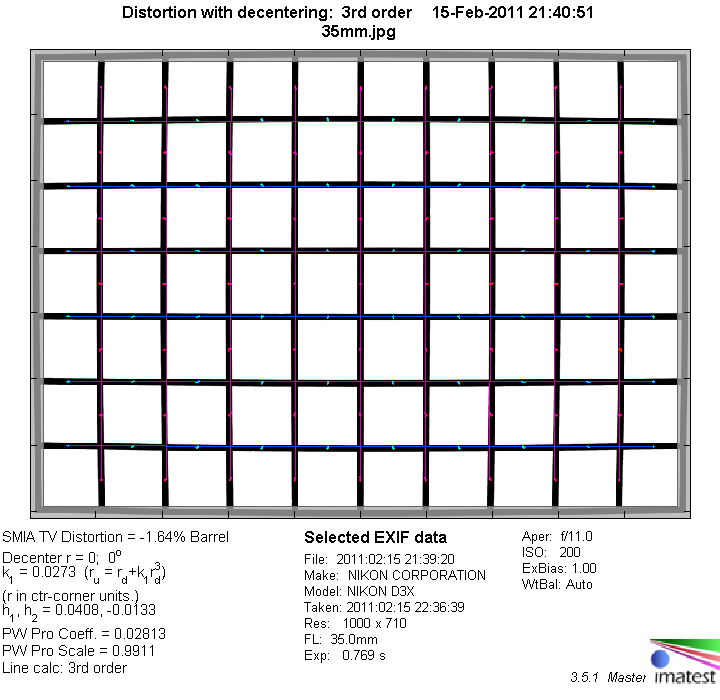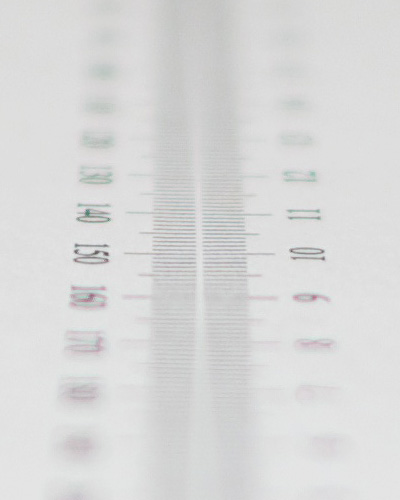|
Page 2 of 3

Distortion
The lens shows a moderate amount of barrel distortion which can be visible in critical shots especially with straight lines near the image borders. However, the distortion is symmetrical and easy to correct in post processing.

The chart above has a real-world size of about 120x80cm.
Vignetting
Fast lenses tend to suffer from high vignetting on full frame cameras and the AF-S 35/1.4 is no exception to this rule. In fact, with almost 2.2 EV wide open the amount of vignetting is exceptional (in a negative sense) and higher than on any other lens we've measured so far on the D3x. Such a huge amount of corner darkening is of course clearly visible in the final image. Stopping down helps to reduce vignetting, but even at f/2 the amount of light falloff remains rather high. From f/2.8 onwards vignetting is no longer field-relevant, except for really critical scenes.
We're performing our vignetting analysis based on
(uncorrected) JPEGs straight from the camera. The JPG engine of the Nikon D3x features a rather flat
gradation curve, thus has a moderate contrast characteristic, resulting in comparatively low vignetting figures - the
corresponding Canon figures are roughly 40% higher due to the more
aggressive default contrast setting.

MTF (resolution)
In our lab tests the AF-S 35 delivers a solid performance. The center resolution is very good wide open already, increasing to excellent figures from f/2.0 onwards.
Borders and corners follow a bit behind with good resolution wide open. Stopping down helps to increase the resolution to very good figures, even toeing the line to excellent teritory around f/5.6.
The lens showed a slight amount focus shift when stopping down (residual spherical aberration).
Please note that the MTF results are not directly comparable across the different systems!
Below is a simplified summary of the formal findings. The chart shows line widths
per picture height (LW/PH) which can be taken as a measure for sharpness.
If you want to know more about the MTF50 figures you may check out the corresponding
Imatest Explanations

Chromatic Aberrations (CAs)
Chromatic aberrations (color shadows at harsh contrast transitions) reach almost 2 pixels on the average at the image borders at large apertures, but decrease by stopping down. They might be visible in very large prints (or crops). However, for typical print sizes the problem isn't really field-relevant for most subjects. In addition, CAs can easily be corrected in software or by the camera itself (if you shoot JPEGs and own a current Nikon DSLR).

Bokeh
One of the primary usage scenarios for a large aperture lens is to seperate the main subject from the background. In such an image the quality of the bokeh (out-of-focus blur) is of major significance.
Bad news first - the bokeh wide open is a bit nervous. This is not only true for the transition zone, were most lenses struggle, but also for subjects at some distance from the focal plane. However, this is actually a quite typical behaviour of wide angle lenses with an aspherical element. The good news (not visible in the image below): the bokeh improves quite a bit by stopping down and becomes very smooth at f/2.8.
Thanks to 9 rounded aperture blades, background highlights retain their circular shape throughout the whole aperture range, except towards the image corners. Due to vignetting they are cut off at one side at wide open and to some degree also at f/2. There is a small amount of outlining and some traces of LoCAs (which are typical for this lens class, see next section).

Bokeh Fringing / Longitudinal Chromatic Aberrations (LoCA)
LoCAs (non-coinciding focal planes of the various colors) are a common issue with relatively fast glass. As you can
notice below the halos have different colors - magenta (red + blue) in front of the focus point
and green beyond. Truly "apochromatic" lenses don't show LoCAs but these lenses are very rare especially
below 100mm. Unlike lateral lateral CAs, LoCAs cannot easily be fixed in post processing.
Typical for most fast primes, especially ultra fast ones, the AF-S 35 shows some amount of LoCAs at large aperture settings, which can of course be reduced by stopping down.
In addition, these shots also show the focus shift when stopping down, which was mentioned in the MTF section.
|
Move the mouse cursor over the f-stop marks below to observe the respective LoCAs
|
| f/1.4 |
f/2 |
f/2.8 |
f/4 |
f/5.6 |
|

|
|